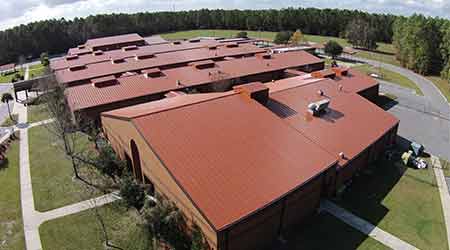 in 2015 the Camden County (Ga.) School System opted to cover the existing standing seam metal roofs on two of its elementary schools with PVC systems.
in 2015 the Camden County (Ga.) School System opted to cover the existing standing seam metal roofs on two of its elementary schools with PVC systems.Roofing: Weather Causes Concerns in Systems Replacement
The weather can throw a wrench in any project, especially roofing. Read about how a Georgia School district handled the weather during a roofing system replacement.
Part two of a three part series.
Working with the weather
Blackerby’s reasons for not wanting to remove the previous roof system involve, in part, the region’s tumultuous weather, which kicks up thunderstorms regularly.
“They can really wreak havoc if you’re in the middle of a roofing project and you start getting high winds and that type of stuff,” he says. “Mary Lee Clark School is located less than 8 miles from the ocean. Every afternoon, as the wind blows across the ocean, it stirs up a thunderstorm. If you’re trying to replace a roof, you pretty much have your morning hours. After lunch, you better start looking out and getting your materials stored because you’re going to have bad weather.”
The district covered the standing seam metal roofs with a PVC roofing system from Sika Sarnafil. The installation involved filling the pans between the existing roof’s standing seams with expanded polystyrene insulation and overlaying polyisocyanurate insulation on top, which also increased the R-value of the roofing system. Installers then adhered the new membrane using an adhesive with low levels of volatile organic compounds. To give the new roof the look of standing seam metal, installers adhered ridges over that layer.
The projects were completed during mid-May through the end of July.
“Work began during the last few weeks of the school year, and the majority of the job was completed before school started in first week of August,” Blackerby says. The total cost for the new 86,000-square-foot roof on Mary Lee Clark was $1.3 million, while the total cost for the new 84,700-square-foot roof on Matilda Harris Elementary School was $1.4 million.
Benefits and lessons
One important goal of any facility retrofit project is to curtail the costs by eliminating failing systems and equipment that cut deeply into resources of the organization, particularly the maintenance and engineering department. By that measure, the district’s dual roof replacement projects succeeded.
“It’s almost been install and forget it,” Blackerby says. “Going back to Woodbine in 2013 and then through these two projects, we just haven’t had to address any issues. It’s not even a thought in our minds that we need to do a lot of inspecting and worrying about the condition of the roof.
“It does free up that time because we don’t have to go check to see if any seams are separated or any fasteners have come loose. For our maintenance guys, it’s not something they have to think about on a day-to-day basis.”
The projects also have helped the district streamline the process of managing facility upgrades in the face of daunting challenges related to time and weather.
“When we did the Woodbine elementary roof, it took longer than we wanted,” Blackerby says. “It overlapped with some key dates on our school calendar, and we had to stop work a few times, which was not ideal. As we got to the Mary Lee Clark and Matilda Harris projects, we did stick to the schedule a little better.
“We’ll continue to refine the installation schedule. The end of the (school) year is always a big time with testing, and teachers don’t like to be disturbed. As we roll into summer, weather becomes a factor. Then we need to have all these projects wrapped up before people start coming back into the buildings for early enrollment at the end of the summer. We have a short window to operate in. We only have about seven good weeks, so staying on top of the schedule is important.” Blackerby and his department also tapped into outside expertise in bringing greater efficiency to the reroofing process.
“The state of Georgia has a capital outlay program that reimburses us for some of the costs of a renovation project if it meets certain qualifiers. As part of that program, we’re required to have an architect oversee the project, and that has helped us further refine the installation schedule. It also gave us an extra set of feet on the ground to make sure that everything was happening accordingly. If we did another (re-roofing project), I think we’d be even more prepared as far as making sure we had the materials when we need them and the workers on the ground — or the roof, as the case may be.”
Related Topics:




















